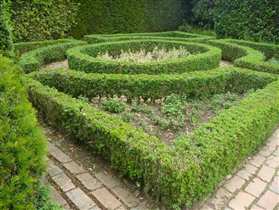Hedges are a very popular formal garden element, and while they may seem quite high maintenance once they are established it is relatively easy to keep your hedges looking good. Pruning a formal hedge may seem like a daunting task but with the right tools and a little planning you can keep your hedges looking attractive, neat and healthy.

Tools:
- Hand shears – These are the best choice for the home gardener. They allow much better control when pruning than electric hedge trimmers. They allow you to achieve a closer and cleaner cut on branches, are safe and quiet and will not shred or tear branches and leaves.
- Pruning Saw- This is for larger branches which are too thick to cut with hand shears.
- Electric trimmer- If you need to prune a large area of formal hedging an electric trimmer may be the best option where hand-pruning is unsuitable.
- String and 2 stakes or poles to create a straight guide line to prune along.
How to prune your Hedge:

- Begin by trimming out all dead or diseased branches, cutting off as close to the main stem of the shrub as possible. This will encourage new growth from the base and middle of the shrub, and allow light in to the inner branches.
- Position your stakes or poles at either end of the section of hedge to be trimmed. Set up your guide line at the desired finished height of the hedge. This makes it a lot easier to create a neat and straight edge when pruning a hedge.
- Starting along the top, begin shaping your hedge. Prune the top along the guide line at the planned height. Work your way along gradually creating a neat flat top all the way along your hedge. You may need a ladder for this if your hedge is very tall.
- Trim off all stray and overgrown branches, cutting as close to the main stem as you can. Trim back all new growth by tip pruning to encourage branching. At this point you should keep in mind your desired shape and height and work to these. Once you have done the top you can begin to work your way down the sides in sections, pruning to the desired shape, you can prune your edges either straight or slightly rounded.
- You can gradually move your guideline down the stakes as you prune down the sides of the hedge. This can be especially helpful for tall hedges that may be more difficult to judge by eye, and will help you to keep to the desired width all along the hedge, creating a border to help you prune your hedge to a neat symmetrical shape.
- When you’re done; gather up the hedge trimmings left on top of and around the hedge, making sure to brush all trimmings of f the top of the hedge. You can use a straw broom or a small hand brush or rake to remove all trimmings from the hedge. These can then be added to a compost pile or thrown away, don’t leave them on and around your hedge as they will encourage pests and diseases.
- Feed and Mulch your hedge plants after you have pruned them to encourage healthy and vigorous new growth.
As they are planted so densely hedge plants compete with each other for food and water, applying a slow release fertiliser and a good thick layer of mulch at the base of the plants after pruning will keep your hedges looking good all year round.
- Most well established Hedges should only require pruning about twice a year; once at the beginning of spring when the plants are starting to show new growth and then once again at the beginning of summer to maintain shape.
- The first Pruning is to remove stray branches and old or diseased wood, this allows light to penetrate to the inner branches, encouraging thick bushy growth from the middle of the hedge. This lays the groundwork for lush, thick hedges year round and helps to fill in thin or brown patches.
- Pruning a second time at the end of spring or beginning of summer allows you to shape the hedge neatly in your desired style.
Pruning a new Hedge:
- Newly established hedges do require a bit more attention for their first few years, however with a little patience and care you will be rewarded with an attractive garden feature that will thrive for many years to come.
- Tip-prune all the plants in your hedge regularly for the first couple of years, before they have reached their final height. This encourages thick healthy growth and is very important for establishing an attractive formal hedge. Make cuttings from your tip-pruning trimmings. This way you can have established plants ready to go to fill in any gaps that appear in your hedge.
About the author
Angus Stewart is the author of several horticutural books including "Creating an Australian Garden". Angus also appears regularly on Australian television and radio shows. Angus's website is called "Gardening with Angus".
